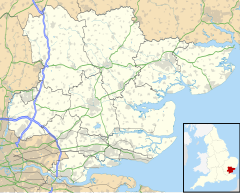Paglesham
| Paglesham | |
|---|---|
 Paglesham's village sign | |
Location within Essex | |
| Population | 246 (2011)[1] |
| OS grid reference | TQ9321892431 |
| Civil parish |
|
| District | |
| Shire county | |
| Region | |
| Country | England |
| Sovereign state | United Kingdom |
| Post town | ROCHFORD |
| Postcode district | SS4 |
| Dialling code | 01702 |
| Police | Essex |
| Fire | Essex |
| Ambulance | East of England |
| UK Parliament | |
Paglesham (/ˈpæɡəlʃəm/ PAG-əl-shəm[2]) is a village and civil parish in the north east of the Rochford Rural District, Essex. The parish includes two hamlets of Eastend and Churchend, which are situated near the River Crouch and Paglesham Creek. It is part of the Roach Valley Conservation Zone.
At the Eastend is The Plough and Sail Public House. There is an unmade road (Waterside Road) full of large potholes leading to a boatyard on the River Roach. There are a small number of houses and a pub, the Plough and Sail.

At Churchend is St Peter's Church. There are a small number of houses and two farms. The Punch Bowl Inn, which was closed, reopened in 2024.
The two hamlets form one of Essex's oldest fishing villages and the area was once renowned as a smuggling centre.[3] This included being home to one of the more famous smugglers in the region, Hard Apple, who was actually the parish councillor and local constable William Blyth.[4]
Admiralty records show that the celebrated vessel HMS Beagle, in which Charles Darwin circumnavigated the world, ended its days as a static ship in the river near Paglesham Eastend, guarding against smugglers. It is speculated that the keel of the vessel may yet survive, buried in the mud of the riverbank.
Paglesham was also an old civil parish, connected to Rochford.
Village sign
[edit]The Paglesham village sign which stands by the approach road was designed and made by resident Rodney Choppin in response to a general initiative to mark the Millennium by Rochford District Council, and the decision to commission a village sign was taken by the Parish Council. It was erected in September 2000. The sign is made from hardwood, hand-carved and then painted. The post is English Oak from Thetford Forest. The pictures represent the agricultural and seafaring traditions of the village. Flanking the Essex shield underneath, are a Pagle (or Cowslip), and an Oyster shell.
Cultural references
[edit]The village was the focus of Julie Christie's character in the film Heaven Can Wait with Warren Beatty.[5] It was also the setting for Garry Kilworth's children's novel The Raiders.
References
[edit]- ^ "Parish population 2011". Neighbourhood Statistics. Office for National Statistics. Retrieved 23 September 2015.
- ^ clive king (23 February 2013). "Paglesham History". YouTube. Archived from the original on 1 July 2023. Retrieved 1 July 2023.
- ^ "Paglesham on Rochford District Council". Archived from the original on 19 October 2007.
- ^ "Making History: William Blyth - the Paglesham smuggler".
- ^ Davis, Nick (2010). Morrison, James (ed.). Hollywood reborn : movie stars of the 1970s. New Jersey: Rutgers University Press. p. 193. ISBN 9780813547480.
External links
[edit]
